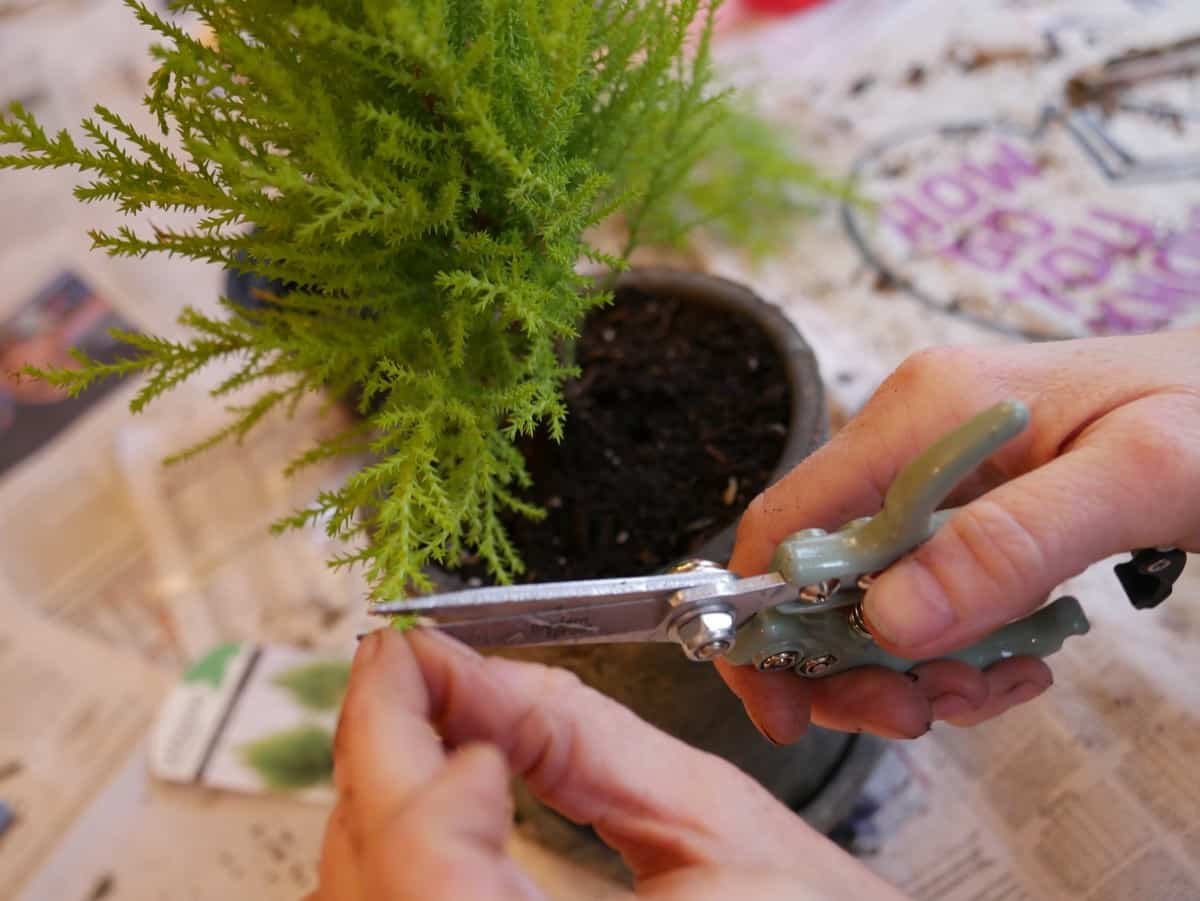A healthy and productive garden requires regular pruning, which is easier than you think. Pruning gives plants a proper shape and direction, develops a strong framework, controls unwanted growth, increases flowering branches, removes dead & decaying branches, etc. It is, therefore, advisable to prune your garden regularly. Furthermore, it ensures that your indoor gem remains fresh and well-presented and supports its sustainable growth.

Trimming Techniques for Container Plants
Why Container Plants Need to be Pruned
It is useful to prune shrubs grown in containers for preventive maintenance, even though they may not require much pruning. As a result, fruit or flower development is encouraged, and insect or disease damage is reduced. A plant’s shape and size can be changed through pruning for aesthetic reasons. This can be accomplished by creating a charming topiary or preserving a desirable form. When you remove dead or dying branches and branches damaged by wind or storm, your plants will be healthier.
When to Prune Container Plants
The best period to prune is early spring before new growth begins or late winter. This short exposure interval (i.e., susceptibility to diseases) allows wounds on the plant to heal quickly. Observing a plant’s shape before leaves emerge and obscuring the branch structure is easier. Exceptions to this rule are plants that bloom on growth from the previous year early in the growing season. You may want to wait until they bloom before pruning them.
Pruning Techniques & Methods
Pruning plants can be accomplished in several ways; some of these methods might even be used in your garden already.
Deadheading
Deadheading involves removing the flowers as soon as a plant is finished blooming. The removal of faded flowers prevents self-seeding and encourages new blooms. Furthermore, perennials are encouraged to form new foliage and build energy for the next season rather than waste energy-producing seeds. A good example is chives, columbine, black-eyed Susans, and salvia, aggressive self-sowers. Marigolds, zinnias, and geraniums also benefit from deadheading.
Thinning
Plants will likely get fungal diseases like powdery mildew when they become thick and dense in the center. As a result of those crowded center branches being choked out or not getting enough light, they can also die off in the middle. The thinning of trees allows for better airflow and opens them up. You should remove some branches in the center, so the healthiest can thrive disease-free.
Maintenance Pruning
Keep your garden in good condition by regularly trimming off dead or diseased leaves. Your gardens will stay healthy and beautiful if you follow these steps. It is best to prune perennials after they have bloomed for the summer to remove dead or dying leaves. Doing this opens up the space around the spent perennial, allowing the other flowers to stand out and flourish.
Hard Pruning
Some plants can become so overgrown if they aren’t pruned regularly that they must be drastically cut back to return to their original glory. In hard pruning, a plant is cut back to become much shorter than before. Depending on the plant, the exact amount may vary. It is, therefore, important to use this method with caution. Plants will not grow back when over-pruned, so use it carefully.
In case you missed it: How to Make Chrysanthemums Bushy: Best Homemade Fertilizers, Composting, and Pruning Tips

Pinching
In nature, plants grow vigorously from one central shoot much faster than from other side branches. Apical dominance is used to describe this phenomenon. An important purpose of pruning is to remove this rapidly growing apical shoot in the center to reduce apical dominance completely. This promotes uniform growth of lateral branches. As a result, the plant attains its proper shape. In herbaceous plants, topping or pinching refers to removing the growing point of a shoot. For example, seasonal flowering and vegetable plants like tomatoes, chillies, capsicums, and gourds.
How to Prune Plants
Ensure the tools are clean and sharp before you begin. Trees, shrubs, and plants can all be pruned using the tips below.
Shrubs
Pruning back dead growth on flowering shrubs such as Lilacs, Roses, Weigelas, Russian sages, Hydrangeas, and Lavender is important, as the dead growth should be cut back to the first new buds on each stem or the ground if no new growth has appeared. Prune back lilacs and weigelas every few years to prevent them from thinning out in the middle.
Trees
If dead or damaged branches appear on trees such as Linden, Cherry, Apple, and Crabapple, they should be cut off at any time of the year. Trees can also be pruned to keep them from growing too dense and to allow for better airflow. Remove any suckers growing from the trunk regularly. The suckers not only look bad but also drain the tree’s energy.
Vines
Clematis and honeysuckle vines should be pruned off dead vines with no new growth. Due to this, they will remain in good shape and size. Don’t cut vines below new growth (sometimes they can get tangled, so hard to see what you’re doing). Cut just above new leaf buds and not below new growth.
Perennial Plants
Pruning perennials is possible once they have finished blooming. The spent flower stems can usually be trimmed back. To make the leaves more shapely, you can also cut them back. Be careful not to remove too much green foliage since perennials and spring bulbs need their leaves to build up their energy for next year.
Vegetables & Herbs
Trimming some veggies once in a while is beneficial. Plants such as tomatoes and herbs benefit from regular pruning or pinching during the growing season. It promotes healthy growth and food production and improves air circulation, preventing disease and fungus.
Benefits of Pruning Plants
Pruning your garden regularly is very beneficial for keeping it healthy and looking good. Below are some of the benefits of trimming your plants regularly
- Promotes plant health: It allows plants to concentrate on producing fresh, healthy growth when dead or dying branches are removed.
- Encourages branching, flowering, and fruiting: By trimming back excess branches, runners, and other extraneous branches, the plant’s energy can be focused on flowering and fruiting.
- Controls size and shape: Regular pruning of plants, shrubs, and trees prevents them from becoming overgrown and taking over a space. As a result, they remain in good shape.
- Prevents disease: Preventing insect pests and diseases by keeping the garden clear of dead plant material.
In case you missed it: Bombay Green Mango Farming: A Comprehensive Guide to Planting, Pruning, Care, and Harvest

Conclusion
Good gardeners do regular daily tasks like deadheading, weeding, supporting, feeding, and watering as needed. You will have a magnificent, beautifully groomed garden that will reward you with hours of enjoyment for years to come if you remove the dead, care for the healthy, and encourage new growth.
- Ultimate Guide to Ossabaw Island Hog: Breeding, Raising, Diet, and Care
- Ultimate Guide to Juliana Pig: Raising Facts, Size, Diet, Care, and Lifespan
- Raising Lleyn Sheep: Disadvantages, Price, Uses, Characteristics, and Care
- Ultimate Guide to Meishan Pig: Breed Facts, Breeding, Raising, and Care
- Ultimate Guide to Teacup Pigs: Raising, Diet, Lifespan, Cost, and Care
- Guide to Raising Poll Dorset Sheep: Facts, Profile, Characteristics, Uses, and Care
- Ultimate Guide to Bighorn Sheep: Characteristics, Diet, Lifespan, Breeding, and Lifecycle
- Ultimate Guide to Raising Katahdin Sheep: Farming Facts, Breed Profile, Uses, and Care
- Ultimate Guide to Raising Oreo Cows: Belted Galloways Farming Facts, Profile, Uses, and Care